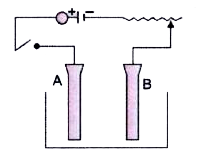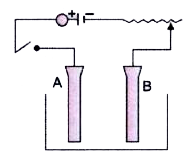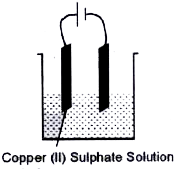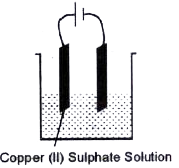Complete Solutions to QUESTIONS FROM PREVIOUS ICSE BOARD PAPERS of chapter ELECTROLYSIS of Class 10 book with complete answers and questions
| Class 10 | CHEMISTRY |
| Chapter | ELECTROLYSIS |
| EVERGREEN PUBLICATION | QUESTIONS FROM PREVIOUS ICSE BOARD PAPERS |
| Number Of Questions | 96 |
| Academic Year | 2023-24 |
Identify the following terms by matching them with appropriate description, write down the letter of the correct answer using each letter only once. A. Anode B. Cation C. lon D. Anion E. Cathode.
Positive or negative particle
View SolutionIdentify the following terms by matching them with appropriate description, write down the letter of the correct answer using each letter only once. A. Anode B. Cation C. lon D. Anion E. Cathode.
Positive particle
View SolutionIdentify the following terms by matching them with appropriate description, write down the letter of the correct answer using each letter only once. A. Anode B. Cation C. lon D. Anion E. Cathode.
Negative particle
View SolutionIdentify the following terms by matching them with appropriate description, write down the letter of the correct answer using each letter only once. A. Anode B. Cation C. lon D. Anion E. Cathode.
Positive particle
View SolutionIdentify the following terms by matching them with appropriate description, write down the letter of the correct answer using each letter only once. A. Anode B. Cation C. lon D. Anion E. Cathode.
Negative electrode.
View SolutionA metal article is to be electroplated with silver. Answer the questions :
Which ions must be present in electrolyte ?
View SolutionA metal article is to be electroplated with silver. Answer the questions :
What will be the nature of the (1) anode (2) cathode?
View SolutionA metal article is to be electroplated with silver. Answer the questions :
Name the gas evolved at anode when following are electrolysed : 1. Molten lead bromide. 2. Concentrated hydrochloric acid. 3. Acidulated water.
View SolutionExplain why copper, though good conductor of electricity, is a non-electrolyte ?
View SolutionName the gas released at cathode when acidulated water is electrolysed.
View SolutionExplain why solid sodium chloride does not allow the electricity to pass through.
View SolutionFill in the blanks :
As we descend the electrochemical series, containing cations, the tendency of cations to get .............. (oxidised/reduced) at cathode increases.
View SolutionFill in the blanks :
The (higher/lower).............. the concentration of an ion in a solution, the greater is the probability of its being discharged at its appropriate electrode.
View SolutionStudy the diagram given below and answer the question that follow

Give the names of the electrodes A and B.
View SolutionStudy the diagram given below and answer the question that follow

Which electrons is the oxidising electrode ?
View SolutionA strip of copper is placed in four different colourless salt solutions. They are
View SolutionWrite the equation of the reactions which take place at the cathode and anode when acidified water is electrolysed.
View SolutionMolten ionic compound
View SolutionCarbon tetrachloride
View SolutionAn aluminium wire
View SolutionA solution containing solvent molecules, solute molecules and ions formed by the dissociation of solute molecules.
View SolutionA sugar solution with sugar molecules and water molecules
View SolutionDuring the electrolysis of molten lead bromide, which of the following takes place :
Bromine is released at the cathode
View SolutionDuring the electrolysis of molten lead bromide, which of the following takes place :
Lead is deposited at the anode
View SolutionDuring the electrolysis of molten lead bromide, which of the following takes place :
Bromine ions gain electrons
View SolutionDuring the electrolysis of molten lead bromide, which of the following takes place :
Lead is deposited at the cathode.
View SolutionHere is an electrode reaction
At which electrode (anode or cathode) would such a reaction take place ? Is this an example of oxidation or reduction.
View SolutionA solution contains magnesium ions
View SolutionWhy is carbon tetrachloride, which is a liquid and non-electrolyte ?
View SolutionA metal article is to be electroplated with silver. The electrolyte selected is sodium argentocyanide.
What kind of salt is sodium argentocyanide?
View SolutionA metal article is to be electroplated with silver. The electrolyte selected is sodium argentocyanide.
Why is it preferred to silver nitrate as an electrolyte?
View SolutionA metal article is to be electroplated with silver. The electrolyte selected is sodium argentocyanide.
State one condition to ensure that the deposit is smooth, firm and long lasting.
View SolutionA metal article is to be electroplated with silver. The electrolyte selected is sodium argentocyanide.
Write the reaction taking place at the cathode.
View SolutionA metal article is to be electroplated with silver. The electrolyte selected is sodium argentocyanide.
Write the reaction taking place at the anode.
View SolutionAqueous solution of Nickel sulphate contains
Which ion moves towards the cathode?
View SolutionAqueous solution of Nickel sulphate contains
What is the product at the anode ?
View SolutionMr. Ramu wants to electroplate his key chain with nickel to prevent rusting. For this electroplating:
Name the electrolyte
View SolutionMr. Ramu wants to electroplate his key chain with nickel to prevent rusting. For this electroplating:
Name the cathode
View SolutionMr. Ramu wants to electroplate his key chain with nickel to prevent rusting. For this electroplating:
Name the anode
View SolutionMr. Ramu wants to electroplate his key chain with nickel to prevent rusting. For this electroplating:
Give the reaction at the cathode
View SolutionMr. Ramu wants to electroplate his key chain with nickel to prevent rusting. For this electroplating:
Give the reaction at the anode.
View SolutionThree different electrolytic cells A, B and C are connected in separate circuits. Electrolytic cell A contains sodium chloride solution. When the circuit is completed, a bulb in the circuit glows brightly. Electrolytic cell B contains acetic acid solution and in this case the bulb in the circuit glows dimly. The electrolytic cell C contains sugаr solution and the bulb does not glow. Give a reason for each of these observations.
View SolutionA compound which liberates reddish brown gas around the anode during electrolysis in its molten state is :
Sodium chloride
Copper (II) oxide
Copper (II) sulphate
Lead (II) bromide
View SolutionGive reasons as to why:
the electrolysis of acidulated water is considered to be an example of catalysis.
View SolutionDifferentiate between electrical conductivity of copper sulphate solution and copper metal.
View SolutionDuring the electrolysis of copper (II) sulphate solution using platinum as cathode and carbon as anode :
What do you observe at the cathode and at the anode?
View SolutionDuring the electrolysis of copper (II) sulphate solution using platinum as cathode and carbon as anode :
What change is noticed in the electrolyte?
View SolutionDuring the electrolysis of copper (II) sulphate solution using platinum as cathode and carbon as anode :
Write the reactions at the cathode and at the anode.
View SolutionSome word/words are missing in the following statement. You are required to rewrite the statement in the correct form using the appropriate word/words:
Cations migrate during electrolysis.
View SolutionIdentify the weak electrolyte from the following: (A) Sodium Chloride solution (B) Dilute Hydrochloric acid (C) Dilute Sulphuric acid (D) Aqueous Acetic acid.
View SolutionGive reasons for the following: An aqueous solution of sodium chloride conducts electricity.
View SolutionSelect the correct answer from the list given in brackets :
An aqueous electrolyte consists of the ions mentioned in the list, the ion which could be discharged most readily during electrolysis.
View SolutionSelect the correct answer from the list given in brackets :
The metallic electrode which does not take part in an electrolytic reaction. (Cu, Ag, Pt, Ni).
View SolutionSelect the correct answer from the list given in brackets :
The ion which is discharged at the anode during the electrolysis of copper sulphate solutions using copper electrodes as anode and cathode.
View SolutionSelect the correct answer from the list given in brackets :
When dilute sodium chloride is electrolysed using graphite electrodes, the cation is discharged at the cathode most readily.
View SolutionSelect the correct answer from the list given in brackets :
During silver plating of an article using potassium argentocyanide as an electrolyte, the anode material should be (Cu, Ag, Pt, Fe).
View SolutionState one appropriate observation for each of the following: Electricity is passed through molten lead bromide.
View SolutionWhich of these will act as a non-electrolyte?
View SolutionCopper sulphate solution is electrolysed using copper electrodes. Study the diagram given below and answer the question that follows: Which electrode to your left or right is known as the oxidising electrode and why?

View SolutionCopper sulphate solution is electrolysed using copper electrodes. Study the diagram given below and answer the question that follows:

Write the equation representing the reaction that occurs.
View SolutionCopper sulphate solution is electrolysed using copper electrodes. Study the diagram given below and answer the question that follows:

State two appropriate observations for the above electrolysis reaction.
View SolutionWhen fused lead bromide is electrolysed we observe: [A]a silver grey deposit at anode and a reddish brown deposit at cathode; [B] a silver grey deposit at cathode and a reddish brown deposit at anode; [C] a silver grey deposit at cathode and reddish brown fumes at anode ; [D] silver grey fumes at anode and reddish brown fumes at cathode
View SolutionThe electrolyte used for electroplating an article with silver is :
View SolutionGive one word or phrase for the following:
Formation of ions from molecules.
View SolutionGive one word or phrase for the following:
Electrolytic deposition of a superior metal on a baser metal.
View SolutionState your observation in each of the following cases: At the cathode when acidified aqueous copper sulphate solution is electrolyzed with copper electrodes.
View SolutionWhich electrode : anode or cathode is the oxidising electrode ? Why?
View SolutionState one relevant observation for each of the following: At the Anode when aqueous copper sulphate solution is electrolysed using copper electrodes.
View SolutionGive appropriate scientific reasons for the following statements :
During electrolysis of molten lead bromide, graphite anode is preferred to other electrodes
View SolutionGive appropriate scientific reasons for the following statements :
Electrolysis of molten lead bromide is considered to be a redox reaction.
View SolutionDifferentiate between the terms strong electrolyte and weak electrolyte. (stating any two differences)
View SolutionComplete the following table :

View SolutionWrite the equation of the reactions which take place at the cathode and anode when acidified water is electrolysed.
View SolutionThe particles present in strong electrolytes are :
(a) only molecules
(b) mainly ions
(c) ions and molecules
(d) only atoms
View SolutionWrite equations for the reactions taking place at the two electrodes (mentioning clearly the name of the electrode) during the electrolysis of:
Acidified copper sulphate solution with copper electrodes.
View SolutionWrite equations for the reactions taking place at the two electrodes (mentioning clearly the name of the electrode) during the electrolysis of:
Molten lead bromide with inert electrodes.
View SolutionName the product formed at the anode during the electrolysis of acidified water using platinum electrodes.
View SolutionName the metallic ions that should be present in the electrolyte when an article made of copper is to be electroplated with silver.
View SolutionGive reasons why :
Sodium chloride will conduct electricity only in fused or aqueous solution state.
View SolutionGive reasons why :
In the electroplating of an article with silver, the electrolyte sodium argentocyanide solution is preferred over silver nitrate solution.
View SolutionGive reasons why :
Although copper is a good conductor of electricity, it is a non-electrolyte.
View SolutionIdentify the substance underlined, in the following case : The electrolyte used for electroplating an article with silver
View SolutionState the observations at the anode and at the cathode during the electrolysis of :
fused lead bromide using graphite electrodes.
View SolutionState the observations at the anode and at the cathode during the electrolysis of :
copper sulphate solution using copper electrodes.
View SolutionSelect the ion , that would get selectively discharged from the aqueous mixture of the ions listed below:
View SolutionSelect the ion in each case, that would get selectively discharged from the aqueous mixture of the ions listed below:
View SolutionAnswer the following questions with respect to the electrolytic process in the extraction of aluminum :
Identify the components of the electrolyte other than pure alumina and the role played by each.
View SolutionAnswer the following questions with respect to the electrolytic process in the extraction of aluminum :
Explain why powdered coke is sprinkled over the electrolytic mixture.
View SolutionThe electrolysis of acidified water is an example of:
View SolutionGive one word or a phrase for the following statement : Process of formation of ions from molecules which are not in ionic state.
View SolutionState one relevant observation for the following: At the anode, when molten lead bromide is electrolyzed using graphite electrodes.
View SolutionName the gas that is produced in the following case : At the anode during the electrolysis of acidified water.
View SolutionFill up the blank with the correct choice given in bracket. Electrolysis of aqueous sodium chloride solution will form ______ at the cathode. (hydrogen gas/sodium metal)
View SolutionComplete the following table which refers to the conversion of ions to neutral particles.

View SolutionFor the electro-refining of copper
What is the cathode made-up of ?
View SolutionFor the electro-refining of copper
Write the reaction that takes place at the anode.
View Solution
QUESTIONS FROM PREVIOUS ICSE BOARD PAPERS questions and complete solutions for chapter ELECTROLYSIS of EVERGREEN CHEMISTRY (ENGLISH) of Class 10
All Exercises from EVERGREEN PUBLICATION Class 10 CHEMISTRY ELECTROLYSIS
- ADDITIONAL QUESTIONS FOR PRACTICE
- Additional questions
- Assertion and Reason Based Questions
- Figure Based Questions
- Fill in the Blanks
- Multiple choice Questions
- QUESTION
- QUESTION FOR PRACTICE ON EXAMINATION PATTERN
- QUESTIONS
- QUESTIONS (fill in the blanks )
- QUESTIONS FOR PRACTICE
- QUESTIONS FROM PREVIOUS ICSE BOARD PAPERS
- Reason Based Questions
- Unit Test Paper 5 - Electrolysis
- WORK SHEET -1
- WORK SHEET -2
- WORK SHEET -3 (Answer the following questions : )
- WORK SHEET -3 (Complete the following table with respect to extraction of aluminium : )
- WORK SHEET -3 (Fill in the blanks )
- WORK SHEET -3 (Give reasons with regard to electroplating : )
- WORK SHEET -4 (complete the following : )